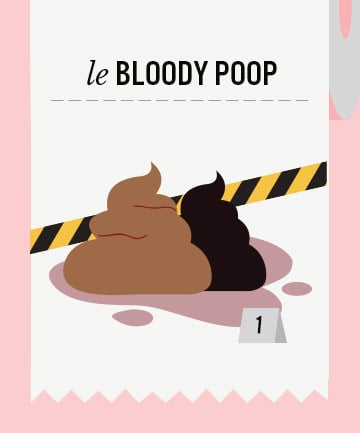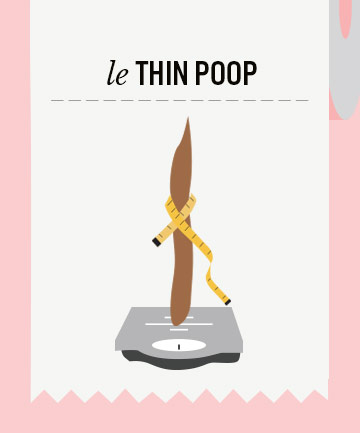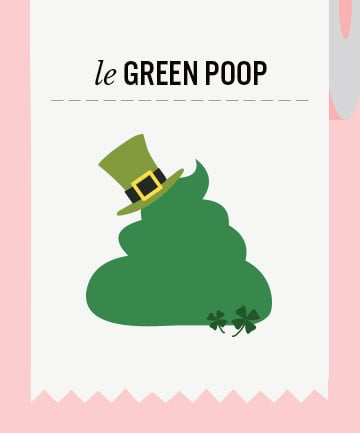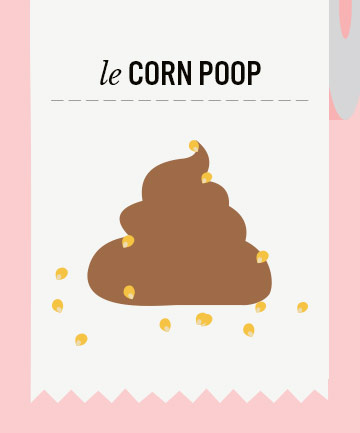What It Looks Like: There are two ways that blood can show up in poop; one is more easily recognizable than the other, appearing — as you might expect — in the form of familiar red blood, while the other is a little more insidious, presenting itself as jet-black stool.
What It Means: "If you see red blood in your stool or very dark stool, then that's something that should prompt some action — most likely you should discuss it with your doctor," says Sheth. "It can indicate a host of things — anything from an ulcer bleeding to colon polyps to something as benign as hemorrhoids."
If you have jet black stool, that's a sign of blood that's originated from higher up, like the stomach. "Blood changes color as it goes downstream," Sheth explains. If you had an ulcer, [blood] would show up black." Alternatively, the redder the blood presents itself, the more likely it is that it originated further downstream. If the bleeding is associated with constipation or hard stools, Sheth says the likely culprit is hemorrhoids but cautions individuals to get checked out if the bleeding is new and represents a change in their norm.
What It Means: "If you see red blood in your stool or very dark stool, then that's something that should prompt some action — most likely you should discuss it with your doctor," says Sheth. "It can indicate a host of things — anything from an ulcer bleeding to colon polyps to something as benign as hemorrhoids."
If you have jet black stool, that's a sign of blood that's originated from higher up, like the stomach. "Blood changes color as it goes downstream," Sheth explains. If you had an ulcer, [blood] would show up black." Alternatively, the redder the blood presents itself, the more likely it is that it originated further downstream. If the bleeding is associated with constipation or hard stools, Sheth says the likely culprit is hemorrhoids but cautions individuals to get checked out if the bleeding is new and represents a change in their norm.
What It Looks Like: This poop is thin-and-narrow, which might be cool if your poop needed to, say, prep its bikini bod, but it just looks plain weird when you're used to seeing something a little more substantial in your toilet bowl.
What It Means: According to Sheth, the usual culprit behind pencil-thin stools is — you guessed it — a lack of dietary fiber. "Because you're constipated, you end up straining and instead of having the anal sphincter muscle open up and relax — which is what normally happens with a bowel movement — you're actually tensing up and clenching so much that the opening through which the stool comes is narrowed and that's going to narrow the stool."
If however, your find your stool is getting progressively narrower and smaller, you may want to consult your doctor, as it may be a sign that rectal cancer is causing the opening to narrow.
What It Means: According to Sheth, the usual culprit behind pencil-thin stools is — you guessed it — a lack of dietary fiber. "Because you're constipated, you end up straining and instead of having the anal sphincter muscle open up and relax — which is what normally happens with a bowel movement — you're actually tensing up and clenching so much that the opening through which the stool comes is narrowed and that's going to narrow the stool."
If however, your find your stool is getting progressively narrower and smaller, you may want to consult your doctor, as it may be a sign that rectal cancer is causing the opening to narrow.
What It Looks Like: The description pretty much says it all; this is a buoyant poop that floats atop toilet bowl water, like an idle vacationer hoping to perfect its tan.
What It Means: Most stools are going to sink — they tend to be denser than water -- but it's normal to have the occasional floater, which is usually the result of gas in the stool. Did you happen to have a bean-heavy burrito for dinner? Then chances are your cuisine is the figurative lifesaver keeping your feces afloat.
But if your floater happens to have a greasy, fatty appearance, it can be a sign of mal-absorption issues — in particular, a difficulty absorbing fat. "When fat goes through the system, it can kind of look like an oil-slick type thing on the surface of the toilet bowl so the stool can actually float," says Sheth. "It's typically greasy-appearing and very foul-smelling, whereas your typical floater with regular dietary changes will not have that same appearance." Sheth goes on to explain that this could be a sign that you have bile duct or pancreatic problems, as these are the things that are involved in digesting fat.
What It Means: Most stools are going to sink — they tend to be denser than water -- but it's normal to have the occasional floater, which is usually the result of gas in the stool. Did you happen to have a bean-heavy burrito for dinner? Then chances are your cuisine is the figurative lifesaver keeping your feces afloat.
But if your floater happens to have a greasy, fatty appearance, it can be a sign of mal-absorption issues — in particular, a difficulty absorbing fat. "When fat goes through the system, it can kind of look like an oil-slick type thing on the surface of the toilet bowl so the stool can actually float," says Sheth. "It's typically greasy-appearing and very foul-smelling, whereas your typical floater with regular dietary changes will not have that same appearance." Sheth goes on to explain that this could be a sign that you have bile duct or pancreatic problems, as these are the things that are involved in digesting fat.
What It Looks Like: Instead of stepping out in its go-to brown, your poop decides to shake things up with head-to-toe green — and not because it's St. Patrick's Day.
What It Means: Eating spinach, green Jell-O or items with artificial food coloring can lend your turd a tinge of green. But if the shade switch-up is accompanied by more frequent bowel movements, that could be a sign of an infection. "There are several classic gastrointestinal infections that can cause this but the most common is Clostridium difficile (commonly called C. difficile)," says Sheth. "You can get this infection if you've been on strong antibiotics, which can disrupt the normal makeup of bacteria in the gastrointestinal tract." Guess it really isn't easy being green, after all.
What It Means: Eating spinach, green Jell-O or items with artificial food coloring can lend your turd a tinge of green. But if the shade switch-up is accompanied by more frequent bowel movements, that could be a sign of an infection. "There are several classic gastrointestinal infections that can cause this but the most common is Clostridium difficile (commonly called C. difficile)," says Sheth. "You can get this infection if you've been on strong antibiotics, which can disrupt the normal makeup of bacteria in the gastrointestinal tract." Guess it really isn't easy being green, after all.
What It Looks Like: This is what Sheth refers to in his book as the "deja poo," wherein you see bits of undigested food in your stool — corn kernels being one of the most common. Think of these substances as little revenants — or something that has returned from the dead — that are in no way, shape or from as good-looking as Leo.
What It Means: Don't worry, your gastrointestinal tract isn't broken. "A lot of the foods we eat, including corn kernels, are basically insoluble fibers that our body is unable to digest," says Sheth. "Corn, various seeds and a lot of plant-based food have cellulose in them, which we cannot digest — so they're going to come out the way they came in. It is completely, 100 percent normal to see those substances in your stool undigested." Other common encore offenders include celery or tomato skins.
What It Means: Don't worry, your gastrointestinal tract isn't broken. "A lot of the foods we eat, including corn kernels, are basically insoluble fibers that our body is unable to digest," says Sheth. "Corn, various seeds and a lot of plant-based food have cellulose in them, which we cannot digest — so they're going to come out the way they came in. It is completely, 100 percent normal to see those substances in your stool undigested." Other common encore offenders include celery or tomato skins.








